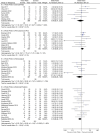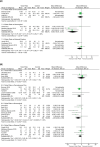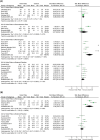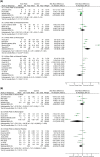Interventions for Distal Radius Fractures: A Meta-analysis of Comparison Studies
- PMID: 34631298
- PMCID: PMC8489996
- DOI: 10.1055/s-0041-1723793
Interventions for Distal Radius Fractures: A Meta-analysis of Comparison Studies
Abstract
Background Distal radius fractures are one of the most frequent orthopaedic injuries. There are many effective treatment methods, such as volar plate, dorsal plate, percutaneous pins, external fixation, and casting; however, comparison of the treatment outcomes has not been thoroughly investigated. Our purpose is to determine if volar plating is the superior treatment method for distal radius fractures. We will address this through the following questions: First, is volar plating superior to dorsal plating, percutaneous pins, external fixation, or casting in terms of reported complications? Second, does volar plating produce superior functional outcomes to dorsal plating, percutaneous pins, external fixation, or casting? Third, are the radiographic outcomes superior for volar plating when compared with dorsal plating, percutaneous pins, external fixation, or casting? Methods MEDLINE, Academic Search Ultimate, Academic Search Complete, CINAHL Plus, and JSTOR databases, as well as manual search, were used to identify papers comparing complications and functional results of volar plating to other treatment methods for distal radius fractures published after the year 2000. Complication data and function scores were recorded. Risk of bias was assessed using the Cochrane Risk of Bias Tool and data was analyzed for meta-analysis using Cochrane ReviewManager software. Results Compared with dorsal plate, volar plate performed significantly better in Gartland and Werley score. Volar plating outperformed percutaneous pins for loss of reduction, infection, Disabilities of the Arm, Shoulder, and Hand (DASH) score, and ulnar deviation. Loss of reduction, malunion, Patient Related Wrist Evaluation (PRWE) score, DASH score, grip strength, ulnar deviation, and supination were significantly better for volar plating when compared with casting. When compared with external fixation, volar plating had significantly less cases of infection, lower QuickDASH score, and higher range of motion for flexion, pronation, and supination. All other complication and functional outcomes were not significantly different. Conclusions Distal radius fractures treated with volar plating showed relatively better measures of complications, function scores, and range of motion than other treatment methods; however, there was no significant difference in healing time when compared with percutaneous pins. More studies are needed to compare the rest of the treatment methods with each other.
Keywords: casting; distal radial fracture; external fixation; percutaneous pins; volar or dorsal plate.
Thieme. All rights reserved.
Conflict of interest statement
Conflict of Interest None declared.
Figures












Similar articles
-
Volar versus dorsal plating in the management of intra-articular distal radius fractures.J Hand Surg Am. 2006 Jan;31(1):9-16. doi: 10.1016/j.jhsa.2005.09.011. J Hand Surg Am. 2006. PMID: 16443097
-
Analysis of the complications of palmar plating versus external fixation for fractures of the distal radius.J Hand Surg Am. 2011 Oct;36(10):1614-20. doi: 10.1016/j.jhsa.2011.06.030. Epub 2011 Aug 17. J Hand Surg Am. 2011. PMID: 21849236
-
Volar Locking Plate Compared With Combined Plating of AO Type C Distal Radius Fractures: A Randomized Controlled Study of 150 Cases.J Hand Surg Am. 2022 Sep;47(9):813-822. doi: 10.1016/j.jhsa.2022.04.018. Epub 2022 Jul 13. J Hand Surg Am. 2022. PMID: 35842329 Clinical Trial.
-
Are Volar Locking Plates Superior to Percutaneous K-wires for Distal Radius Fractures? A Meta-analysis.Clin Orthop Relat Res. 2015 Sep;473(9):3017-27. doi: 10.1007/s11999-015-4347-1. Epub 2015 May 16. Clin Orthop Relat Res. 2015. PMID: 25981715 Free PMC article. Review.
-
The use of dorsal distraction plating for severely comminuted distal radius fractures: A review and comparison to volar plate fixation.Injury. 2019 Jun;50 Suppl 1:S50-S55. doi: 10.1016/j.injury.2019.03.052. Epub 2019 Apr 6. Injury. 2019. PMID: 31040029 Review.
Cited by
-
Evaluating the biomechanical performance of Ti6Al4V volar plates in patients with distal radius fractures.Front Bioeng Biotechnol. 2023 Feb 27;11:1141790. doi: 10.3389/fbioe.2023.1141790. eCollection 2023. Front Bioeng Biotechnol. 2023. PMID: 36923459 Free PMC article.
References
-
- Duramaz A, Bilgili M G, Karaali E, Bayram B, Ziroğlu N, Kural C. Volar locking plate versus K-wire-supported external fixation in the treatment of AO/ASIF type C distal radius fractures: A comparison of functional and radiological outcomes. Ulus Travma Acil Cerrahi Derg. 2018;24(03):255–262. - PubMed
-
- Roh Y H, Lee B K, Baek J R, Noh J H, Gong H S, Baek G H. A randomized comparison of volar plate and external fixation for intra-articular distal radius fractures. J Hand Surg Am. 2015;40(01):34–41. - PubMed
-
- Rozental T D, Blazar P E, Franko O I, Chacko A T, Earp B E, Day C S. Functional outcomes for unstable distal radial fractures treated with open reduction and internal fixation or closed reduction and percutaneous fixation. A prospective randomized trial. J Bone Joint Surg Am. 2009;91(08):1837–1846. - PubMed

